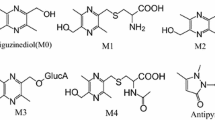Abstract
Magnoflorine, an aporphine alkaloid in Cortex phellodendri, is increasingly attracting research attention because of its antidiabetic effects. However, at present, little information on its pharmacokinetics (PK) in vivo is available. In this study, a sensitive, rapid, and selective method was developed to determine the magnoflorine content in rat plasma using liquid chromatography–tandem mass spectrometry. Following liquid–liquid extraction, the calibration curve showed good linearity within the concentration range of 2.93 to 1,500 ng ml−1. The intra- and inter-day precisions were all below 7.8 %, and the accuracy ranged from 94.9 to 103.4 %. The method was successfully applied in investigating the PK of magnoflorine in rats. The compound had low bioavailability, a high absorption rate, and a high elimination rate. However, area under the curve, T 1/2, and MRT increased approximately twofold when the same dosage of the compound was administered in a C. phellodendri decoction (20.8 g kg−1). Moreover, T max was prolonged from 0.3 to 3.33 h. Furthermore, a comparison of coadministration of the mixture group, magnoflorine (40 mg kg−1) and berberine (696.4 mg kg−1), with the C. phellodendri decoction group, revealed that no statistical difference (P > 0.05) was found in the parameter AUC, and certain similar changes in the PK trend to the herbal medicine group were also observed. These results suggested that oral administration of the herbal medicine decreased the absorption and elimination rates of magnoflorine and increased its bioavailability. Berberine played a significant role in interacting with magnoflorine and in affecting the PK profiles of magnoflorine in the C. phellodendri decoction group.

ᅠ




Similar content being viewed by others
References
Dwumabadu D, Ayim JSK, Withers SF, Agyemang NO, Ateya AM, Elazizi MM, Knapp JE, Slatkin DJ, Schiff PL (1980) Constituents of West African medicinal plants. 27. Alkaloids of Rhigiocarya racemifera and Stephania dinklagei. J Nat Prod 43(1):123–129. doi:10.1021/Np50007a010
Sharma U, Bala M, Kumar N, Singh B, Munshi RK, Bhalerao S (2012) Immunomodulatory active compounds from Tinospora cordifolia. J Ethnopharmacol 141(3):918–926. doi:10.1016/j.jep.2012.03.027
Hung TM, Na MK, Min BS, Zhang XF, Lee IS, Ngoc TM, Thuong PT, Sok DE, Bae KH (2007) Protective effect of magnoflorine isolated from Coptidis rhizoma on Cu2+-Induced oxidation of human low density lipoprotein. Planta Med 73(12):1281–1284. doi:10.1055/s-2007-981615
Chen JH, Du ZZ, Shen YM, Yang YP (2009) Aporphine alkaloids from Clematis parviloba and their antifungal activity. Arch Pharm Res 32(1):3–5. doi:10.1007/s12272-009-1111-7
Patel MB, Mishra SM (2012) Magnoflorine from Tinospora cordifolia stem inhibits α-glucosidase and is antiglycemic in rats. J Funct Foods 4(1):79–86. doi:10.1016/j.jff.2011.08.002
Patel MB, Mishra S (2011) Hypoglycemic activity of alkaloidal fraction of Tinospora cordifolia. Phytomedicine 18(12):1045–1052. doi:10.1016/j.phymed.2011.05.006
Patel MB, Mishra S (2012) Isoquinoline alkaloids from Tinospora cordifolia inhibit rat lens aldose reductase. Phytother Res 26(9):1342–1347. doi:10.1002/ptr.3721
Hu YM, Su GH, Sze SCW, Ye WC, Tong Y (2010) Quality assessment of Cortex phellodendri by high-performance liquid chromatography coupled with electrospray ionization mass spectrometry. Biomed Chromatogr 24(4):438–453. doi:10.1002/Bmc.1311
Editorial Committee of Pharmacopoeia of People’s Republic of China (2010) Pharmacopoeia of People’s Republic of China. China Medical Science and Technology Press, Bei**g, p 286
Kim HJ, Kong MK, Kim YC (2008) Beneficial effects of Phellodendri cortex extract on hyperglycemia and diabetic nephropathy in streptozotocin-induced diabetic rats. Bmb Rep 41(10):710–715
Wang FL, Tang LQ, Yang F, Zhu LN, Cai M, Wei W (2012) Renoprotective effects of berberine and its possible molecular mechanisms in combination of high-fat diet and low-dose streptozotocin-induced diabetic rats. Mol Biol Rep. doi:10.1007/s11033-012-2321-5
Ma CH, Li ZX, Wang LX, Tang YH, **ao HB, Huang CG (2009) Identification of major alkaloids in rat urine by HPLC/DAD/ESI-MS/MS method following oral administration of Cortex phellodendri Decoction. Helv Chim Acta 92(2):379–398
Ma C, Fan M, Tang Y, Li Z, Sun Z, Ye G, Huang C (2008) Identification of major alkaloids and steroidal saponins in rat serum by HPLC-diode array detection-MS/MS following oral administration of Huangbai-Zhimu herb-pair extract. Biomed Chromatogr 22(8):835–850. doi:10.1002/bmc.1000
Yu S, Pang X, Deng Y, Liu L, Liang Y, Liu X, **e L, Wang G, Wang X (2007) A sensitive and specific liquid chromatography mass spectrometry method for simultaneous determination of berberine, palmatine, coptisine, epiberberine and jatrorrhizine from Coptidis rhizoma in rat plasma. Int J Mass Spectrom 268(1):30–37. doi:10.1016/j.ijms.2007.08.003
Deng YT, Liao QF, Li SH, Bi KS, Pan BY, **e ZY (2008) Simultaneous determination of berberine, palmatine and jatrorrhizine by liquid chromatography-tandem mass spectrometry in rat plasma and its application in a pharmacokinetic study after oral administration of coptis-evodia herb couple. J Chromatogr B 863(2):195–205. doi:10.1016/j.jchromb.2007.12.028
Avula B, Wang YH, Rumalla CS, Ali Z, Smillie TJ, Khan IA (2011) Analytical methods for determination of magnoflorine and saponins from roots of Caulophyllum thalictroides (L.) Michx. using UPLC, HPLC and HPTLC. J Pharm Biomed Anal 56(5):895–903. doi:10.1016/j.jpba.2011.07.028
Zhou J, Sun JB, Zheng P, Liu J, Cheng ZH, Zeng P, Wang FQ (2012) Orthogonal array design for optimization of hollow-fiber-based liquid-phase microextraction combined with high-performance liquid chromatography for study of the pharmacokinetics of magnoflorine in rat plasma. Anal Bioanal Chem 403(7):1951–1960. doi:10.1007/s00216-012-6013-8
Atul Bhattaram V, Graefe U, Kohlert C, Veit M, Derendorf H (2002) Pharmacokinetics and bioavailability of herbal medicinal products. Phytomedicine 9:1–33. doi:10.1078/1433-187x-00210
GuidanceforIndustr (2001). Available:http://www.fda.gov/downloads/Drugs/GuidanceComplianceRegulatoryInformation/Guidances/ucm070107.pdf.Accessed. Accessed May 2001
Mohamed SM, Hassan EM, Ibrahim NA (2010) Cytotoxic and antiviral activities of aporphine alkaloids of Magnolia grandiflora L. Nat Prod Res 24(15):1395–1402. doi:10.1080/14786410902906959
Zhou H (2003) Pharmacokinetic strategies in deciphering atypical drug absorption profiles. J Clin Pharmacol 43(3):211–227. doi:10.1177/0091270002250613
Acknowledgments
This study was supported by the State Key Program of National Science Foundation of China (Grant No. 81030065), National Science Foundation of China (Grant No. 81302836) and Major National Science and Technology Programs (Grant No. 2012ZX09301001-006 and 2012ZX09302003).
Author information
Authors and Affiliations
Corresponding authors
Rights and permissions
About this article
Cite this article
Tian, X., Li, Z., Lin, Y. et al. Study on the PK profiles of magnoflorine and its potential interaction in Cortex phellodendri decoction by LC-MS/MS. Anal Bioanal Chem 406, 841–849 (2014). https://doi.org/10.1007/s00216-013-7530-9
Received:
Revised:
Accepted:
Published:
Issue Date:
DOI: https://doi.org/10.1007/s00216-013-7530-9




